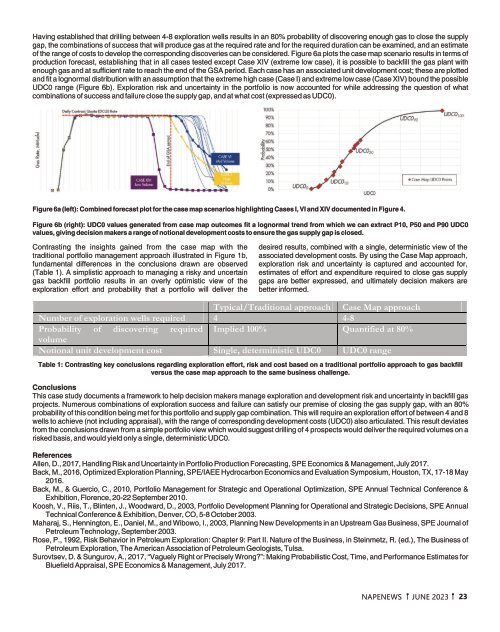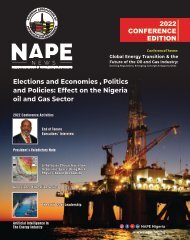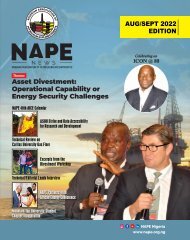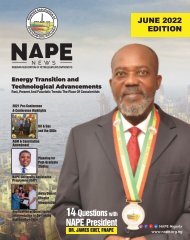NAPENews Magazine June 2023 Edition
NAPENews Magazine June 2023 Edition
NAPENews Magazine June 2023 Edition
Create successful ePaper yourself
Turn your PDF publications into a flip-book with our unique Google optimized e-Paper software.
Having established that drilling between 4-8 exploration wells results in an 80% probability of discovering enough gas to close the supply<br />
gap, the combinations of success that will produce gas at the required rate and for the required duration can be examined, and an estimate<br />
of the range of costs to develop the corresponding discoveries can be considered. Figure 6a plots the case map scenario results in terms of<br />
production forecast, establishing that in all cases tested except Case XIV (extreme low case), it is possible to backfill the gas plant with<br />
enough gas and at sufficient rate to reach the end of the GSA period. Each case has an associated unit development cost; these are plotted<br />
and fit a lognormal distribution with an assumption that the extreme high case (Case I) and extreme low case (Case XIV) bound the possible<br />
UDC0 range (Figure 6b). Exploration risk and uncertainty in the portfolio is now accounted for while addressing the question of what<br />
combinations of success and failure close the supply gap, and at what cost (expressed as UDC0).<br />
Figure 6a (left): Combined forecast plot for the case map scenarios highlighting Cases I, VI and XIV documented in Figure 4.<br />
Figure 6b (right): UDC0 values generated from case map outcomes fit a lognormal trend from which we can extract P10, P50 and P90 UDC0<br />
values, giving decision makers a range of notional development costs to ensure the gas supply gap is closed.<br />
Contrasting the insights gained from the case map with the<br />
traditional portfolio management approach illustrated in Figure 1b,<br />
fundamental differences in the conclusions drawn are observed<br />
(Table 1). A simplistic approach to managing a risky and uncertain<br />
gas backfill portfolio results in an overly optimistic view of the<br />
exploration effort and probability that a portfolio will deliver the<br />
desired results, combined with a single, deterministic view of the<br />
associated development costs. By using the Case Map approach,<br />
exploration risk and uncertainty is captured and accounted for,<br />
estimates of effort and expenditure required to close gas supply<br />
gaps are better expressed, and ultimately decision makers are<br />
better informed.<br />
Table 1: Contrasting key conclusions regarding exploration effort, risk and cost based on a traditional portfolio approach to gas backfill<br />
versus the case map approach to the same business challenge.<br />
Conclusions<br />
This case study documents a framework to help decision makers manage exploration and development risk and uncertainty in backfill gas<br />
projects. Numerous combinations of exploration success and failure can satisfy our premise of closing the gas supply gap, with an 80%<br />
probability of this condition being met for this portfolio and supply gap combination. This will require an exploration effort of between 4 and 8<br />
wells to achieve (not including appraisal), with the range of corresponding development costs (UDC0) also articulated. This result deviates<br />
from the conclusions drawn from a simple portfolio view which would suggest drilling of 4 prospects would deliver the required volumes on a<br />
risked basis, and would yield only a single, deterministic UDC0.<br />
References<br />
Allen, D., 2017, Handling Risk and Uncertainty in Portfolio Production Forecasting, SPE Economics & Management, July 2017.<br />
Back, M., 2016, Optimized Exploration Planning, SPE/IAEE Hydrocarbon Economics and Evaluation Symposium, Houston, TX, 17-18 May<br />
2016.<br />
Back, M., & Guercio, C., 2010, Portfolio Management for Strategic and Operational Optimization, SPE Annual Technical Conference &<br />
Exhibition, Florence, 20-22 September 2010.<br />
Koosh, V., Riis, T., Blinten, J., Woodward, D., 2003, Portfolio Development Planning for Operational and Strategic Decisions, SPE Annual<br />
Technical Conference & Exhibition, Denver, CO, 5-8 October 2003.<br />
Maharaj, S., Hennington, E., Daniel, M., and Wibowo, I., 2003, Planning New Developments in an Upstream Gas Business, SPE Journal of<br />
Petroleum Technology, September 2003.<br />
Rose, P., 1992, Risk Behavior in Petroleum Exploration: Chapter 9: Part II. Nature of the Business, in Steinmetz, R. (ed.), The Business of<br />
Petroleum Exploration, The American Association of Petroleum Geologists, Tulsa.<br />
Surovtsev, D. & Sungurov, A., 2017, “Vaguely Right or Precisely Wrong?”: Making Probabilistic Cost, Time, and Performance Estimates for<br />
Bluefield Appraisal, SPE Economics & Management, July 2017.<br />
NAPENEWS JUNE <strong>2023</strong> 23










